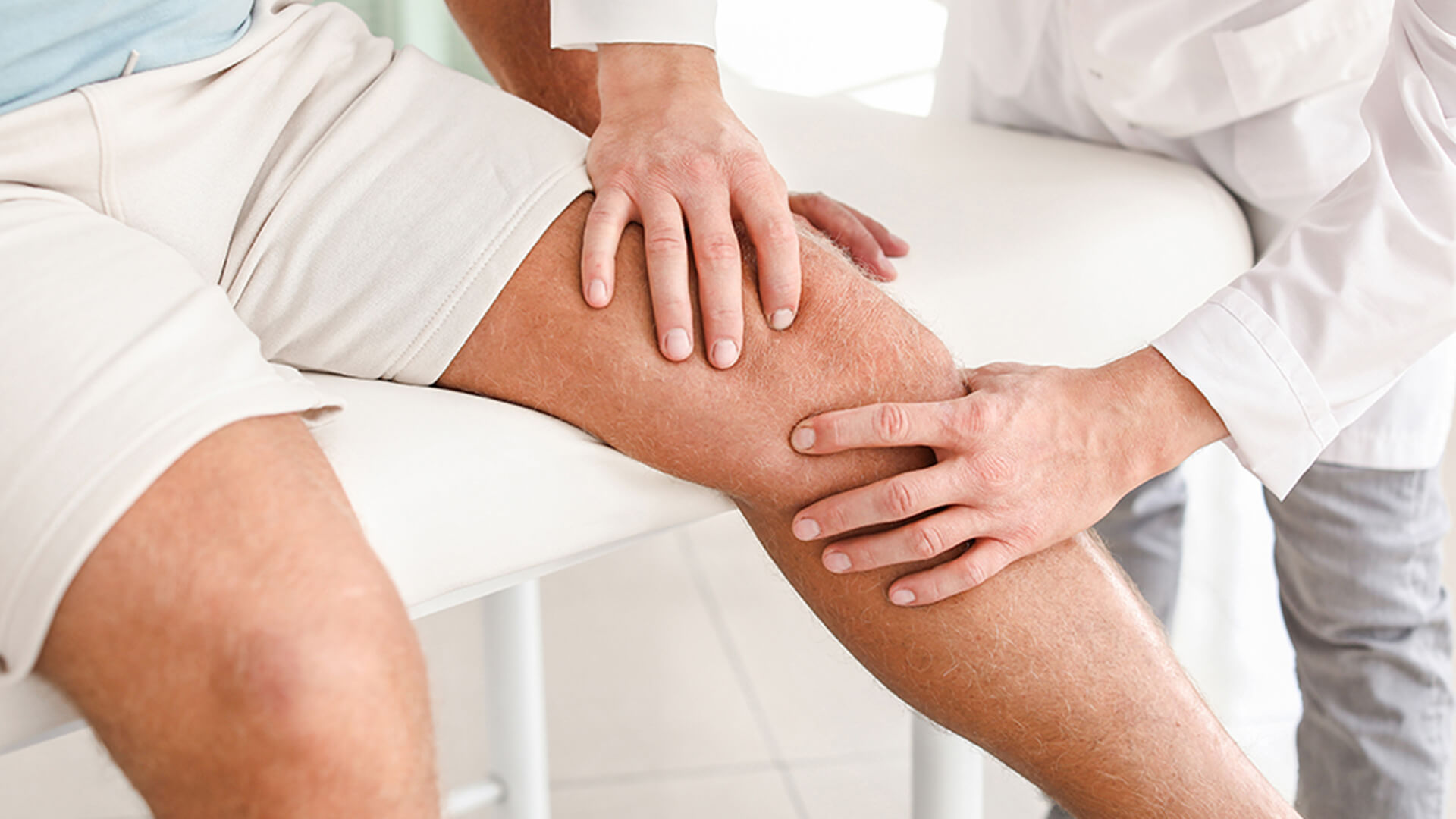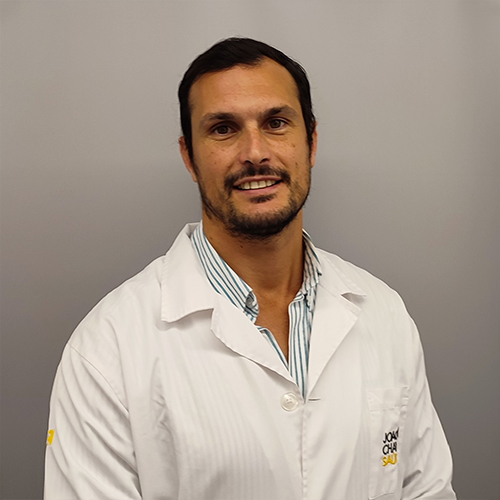This condition is uncommon before the age of 40, and becomes more frequent with age. Over the age of 70, more than 85% of the population experiences symptoms of knee osteoarthritis. Worldwide, this is the fourth condition with the greatest impact on quality of life. Find out the signs and symptoms of this disease, why it happens and how to treat it.
What is knee osteoarthritis?
Knee osteoarthritis is a degenerative condition that affects the knee joint. It occurs when the cartilage that cushions the ends of the knee bones gradually wears away.
Cartilage acts as a shock absorber between bones, allowing joints to move smoothly. However, factors such as ageing, traumatic injuries, being overweight or a genetic predisposition cause the knee cartilage to lose elasticity and begin to deteriorate. As the cartilage wears away, the subchondral bone comes into direct contact with the joint surfaces, resulting in pain, swelling and stiffness.
What are the symptoms of knee osteoarthritis?
The symptoms of knee osteoarthritis can vary in severity and develop over time. Each patient can experience one or several symptoms; the most common include:
Knee pain
Knee pain is the predominating symptom of knee osteoarthritis. It can start off mild and sporadic but, over time, it becomes more constant and intense. Pain is usually felt around, inside or at the front of the knee, and can also occur at rest.
Joint stiffness
Stiffness in the affected knee is common after prolonged periods of rest, such as waking up in the morning or sitting for long periods of time. Stiffness can impair movement, and the knee usually takes some time to regain flexibility.
Inflammation
Knee osteoarthritis can cause inflammation of the knee joint, leading to the accumulation of fluid inside the joint and, consequently, swelling. In advanced stages, the knee can look deformed.
Knee clicking
Some patients with knee osteoarthritis report hearing or feeling clicks when moving the knee, due to breakdown of the cartilage and friction between the bones.
Restricted mobility
As knee osteoarthritis progresses, the knee’s range of motion can become limited. It may be difficult to fully bend or extend the affected knee, and simple movements like climbing stairs or squatting can be painful.
Muscle weakness
Muscle weakness around the knee is common in knee osteoarthritis, particularly when pain and restricted mobility cause patients to become less physically active. Muscle weakness can aggravate symptoms even further and impair adequate knee support.
What causes knee osteoarthritis?
Knee osteoarthritis can develop without obvious risk factors, but usually involves a combination of several genetic, environmental and biomechanical factors. The most common causes include:
Natural wear of joints
Ageing is one the main causes of knee osteoarthritis. As the body ages, cartilage tends to deteriorate, becoming finer and less resistant. Over time, this natural wear increases the risk of developing knee osteoarthritis.
Prior injuries
Knee injuries like sprains, fractures or torn ligaments, can increase the risk of knee osteoarthritis in the future. Prior damage to cartilage or knee bones can lead to structural and functional changes, compromising joint integrity and leading to this condition.
Overloading or overusing the knee
Repetitive or excessive stress on knee joints can play an important role in knee osteoarthritis. Activities that involve repetitive movements like running, jumping or lifting heavy objects incorrectly, can lead to premature wear of the cartilage.
Obesity
Excess weight places a greater burden on knee joints, accelerating cartilage breakdown and increasing the risk of osteoarthritis.
Genetic factors
A genetic predisposition can also play an important role in knee osteoarthritis. Certain genes are associated with changes in cartilage structure and function, and may increase susceptibility to this condition.
How is knee osteoarthritis diagnosed?
Based on the symptoms, physical examination and results of imaging exams, the physician is able to diagnose knee osteoarthritis and determine the severity of the condition. The diagnosis is performed by an Orthopaedist or Rheumatologist, and involves the following steps:
Medical history and physical examination
The physician begins by collecting information on the symptoms, medical history and any prior injuries. The knee’s range of motion, swelling and muscle weakness will also be assessed.
Imaging exams
Some imaging exams may be prescribed to confirm the diagnosis and assess the extent of cartilage damage. X-ray is usually the most common exam to identify signs of cartilage breakdown and other changes that characterise knee osteoarthritis. Magnetic resonance imaging (MRI) can also be useful to provide more accurate information on the condition of the cartilage and possible injuries to ligaments or other structures.
Knee osteoarthritis: treatment?
The goal of treatment for knee osteoarthritis is to relieve pain, improve joint function and reduce the progression of the disease. Treatment can involve a combination of non-surgical measures, depending on the severity of the symptoms and impact on the patient’s quality of life. The most common treatment options include:
Medication
At an early stage, the physician may prescribe painkillers and non-steroidal anti-inflammatory drugs. Prescribing these drugs may be enough to relieve pain and improve the knee’s mobility.
Physiotherapy
Physiotherapy is an important part of knee osteoarthritis treatment. Muscle strengthening exercises, stretching and mobility techniques can help improve the knee’s stability and function, as well as reduce pain.
Weight loss
As being overweight can increase the burden on knee joints, a healthy diet combined with physical exercise helps reduce the burden on joints and relieve pain.
Hyaluronic acid injections
Hyaluronic acid is a substance that is naturally present in joints and has a lubricating and cushioning effect. Hyaluronic acid injections can help improve mobility and relieve symptoms. More recently, platelet-rich plasma (PRP) injections have also been indicated to treat younger patients with mild to moderate knee osteoarthritis.
Surgery
More serious cases of knee osteoarthritis, or those that do not respond to non-invasive therapies, may require surgical procedures. Usually, an arthroplasty is performed, which involves resurfacing damaged knee cartilage with a prosthetic implant (usually metal), or realignment osteotomy, which involves cutting the femur or tibia to align the deformed knee. The recovery time varies, but the patient is expected to fully recover autonomy in 3 or 4 months.
Treating knee osteoarthritis at Joaquim Chaves Saúde
At Joaquim Chaves Saúde, you will find a highly qualified and experienced team in the treatment of knee osteoarthritis. With the support of advanced technology and frontline medical protocols, you will benefit from the best treatment for knee osteoarthritis. Schedule your consultation now and get your quality of life back soon!





